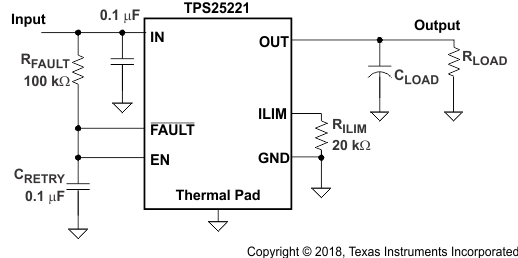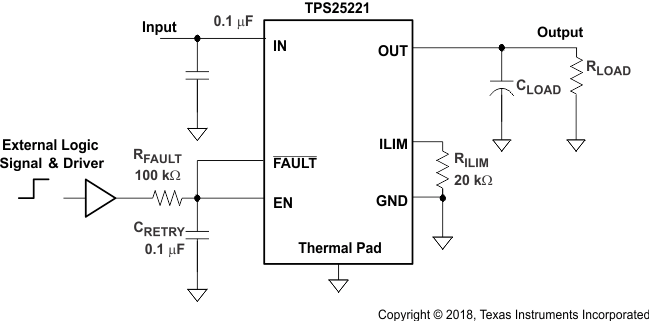ZHCSHI4D January 2018 – December 2019 TPS25221
PRODUCTION DATA.
- 1 特性
- 2 应用
- 3 说明
- 4 修订历史记录
- 5 Device Comparison Table
- 6 Pin Configuration and Functions
- 7 Specifications
- 8 Parameter Measurement Information
- 9 Detailed Description
- 10Application and Implementation
- 11Power Supply Recommendations
- 12Layout
- 13器件和文档支持
- 14机械、封装和可订购信息
封装选项
机械数据 (封装 | 引脚)
散热焊盘机械数据 (封装 | 引脚)
- DRV|6
订购信息
10.2.2 Auto-Retry Functionality
Some applications require that an over-current condition disables the part momentarily during a fault condition and re-enables after a pre-set time. This auto-retry functionality can be implemented with an external resistor and capacitor. During a fault condition, FAULT pulls low disabling the part. The part is disabled when EN is pulled low, and FAULT goes high impedance allowing CRETRY to begin charging. The part re-enables when the voltage on EN reaches the turn-on threshold, and the auto-retry time is determined by the resistor-capacitor time constant. The device continues to cycle in this manner until the fault condition is removed.
 Figure 27. Auto-Retry Functionality
Figure 27. Auto-Retry Functionality Some applications require auto-retry functionality and the ability to enable or disable with an external logic signal. Figure 28 shows how an external logic signal can drive EN through RFAULT and maintain auto-retry functionality. The resistor-capacitor time constant determines the auto-retry time-out period.
 Figure 28. Auto-Retry Functionality With External EN Signal
Figure 28. Auto-Retry Functionality With External EN Signal